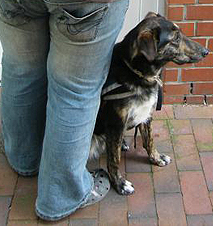PTSD assistance dogs are not normal dogs or therapy dogs. PTSD assistance dogs, together with mobility dogs, guide dogs, autism assistance dogs and alert dogs, are counted among assistance dogs. PTSD assistance dogs are specially trained for the limitations that a complex post-traumatic stress disorder brings with it. This also includes the entire spectrum of dissociative disorders. PTSD assistance dogs give those affected by PTSD the hope of a future! They are specially picked for their work and trained for 18 to 24 months to carry out duties which actively make life with a post-traumatic stress disorder easier. They contribute to reducing limitations in daily life and make life worth living again.
PTSD assistance dogs were already being trained in individual cases by some people effected by the disorder themselves, but they've only been trained by organizations in the last few years. The Assistance Dog Center T.A.R.S.Q.® is, since 2008, the first organization in Europe to train PTSD assistance dogs. PTSD assistance dogs are trained for adults 16 years and up, either in owner training with an assistance dog trainer or fully trained by an assistance dog trainer.
When you don't leave your house for weeks out of fear, a PTSD assistance dog gives you security outside and keeps other people at a distance. Have you ever been standing in the supermarket when you're overtaken by a debilitating panic? You want nothing more than to run away, but you no longer know how or where? PTSD assistance dogs have learned to lead to the exit or to a calm area, until you're feeling better. Your daily life is shaped by flashbacks, dissociative episodes and nightmares? A PTSD assistance dog comforts you and helps you to interrupt these thoughts.
With a PTSD assistance dog, you'll never be alone again. It will accompany you 24/7 and is always happy to be by your side, whether you're having a good day or a bad one.
- Tasks of a PTSD assistance dog
A PTSD assistance dog is individually trained for the requirements and limitations of each person affected by PTSD. PTSD assistance dogs learn external tasks, which are visible to others, and processing tasks, which are not visible to others. One example of a processing task is cognitive behavior. Cognitive behavior combines the techniques that the PTSD sufferer has learned in psychotherapy, with dog commands, which cause certain behaviors or thought patterns to be questioned.
The natural behavior of the dog is also a processing task. The natural behavior is used and encouraged. An example of this is the reality check, when the dog checks if there really is anyone a certain room, when the PTSD sufferer fears that there is. If nobody is there, the dog stays calm. If someone is there, the dog will look at them curiously or greet them.
Another processing task is the regulative behavior of the dog. The dog uses this regulative behavior to make their partner aware of a certain behavior. The PTSD sufferer then employs techniques learned in psychotherapy. If the dog alerts the partner that a flashback is occuring, the partner can employ methods learned in psychotherapy to control flashbacks.
PTSD assistance dogs learn to provide a sense of security when opening doors, by keeping their gaze fixed to the rear, creating distance from strangers, barking as a deterrent on command, turning on lights in dark rooms, searching rooms for intruders, giving reminders about medication and prompting the partner to take it. PTSD assistance dogs can also learn to fetch a cell phone, so that support can be called for in a crisis.
A PTSD assistance dog can learn to bring its partner back home or to the car while they're in a dissociative fugue. If the partner is having a panic attack or a dissociate episode, the assistance dog can lead the way to the exit of a shop, or to a secure seating area. If needed, an assistance dog can learn to interrupt flashbacks and dissociative episodes, turn on the light during nightmares and bring comfort through its closeness during panic attacks or flashbacks. It can learn to follow shop assistants or medical personal on command during dissociative episodes, lead the way through crowds of people, and head towards corners. Trained PTSD assistance dogs wear an assistance dog vest in public, on which is "only" written assistance dog - the type of illness is not advertised. However, you should be aware, if you want a PTSD assistance dog, that it will be apparent in public that you have an illness, even if the exact nature of the illness remains private.
- Scientific studies on PTSD assistance dogs
Between 2010 and 2012 the German Assistance Dog Center T.A.R.S.Q. carried out a study on the benefits of PTSD assistance dogs. 15 PTSD assistance dog owners were surveyed for the study. All the owners reported that their quality of life had been improved by a PTSD assistance dog. Four of the participants had not left the house for between several months and two years prior to receiving a PTSD assistance dog, and reported going outside again on a daily basis, and being able to go shopping again. All participants experienced a reduced level of anxiety and fewer dissociative episodes and flashbacks.
- Preconditions for having a PTSD assistance dog
- You suffer from a complex post-traumatic stress disorder and have already completed a course of psychotherapy, or are currently undergoing psycho-therapeutic treatment.
- You find yourself restricted in many areas of your day-to-day life due to your PTSD.
- You have a support network, so that care of the dog is guaranteed in a crisis.









